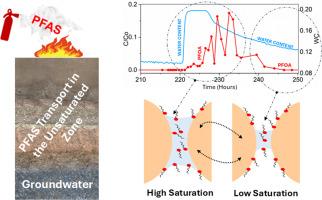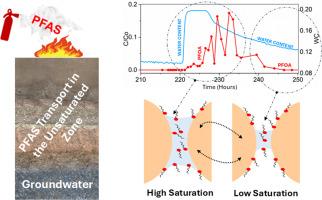入渗循环中多化合物PFAS在非饱和带的输运
IF 12.4
1区 环境科学与生态学
Q1 ENGINEERING, ENVIRONMENTAL
引用次数: 0
摘要
全氟烷基和多氟烷基物质(PFAS)是持久性环境污染物,已知其在地下环境中长期保留。长链和短链PFAS (PFOS、PFOA、PFHxA和PFPeA)的同时运移在一个大(3米)的柱中进行了研究,该柱旨在模拟不饱和区通过周期性入渗循环的瞬态流动条件。本文章由计算机程序翻译,如有差异,请以英文原文为准。


Multi-compound PFAS transport in the unsaturated zone during infiltration cycles
Per- and Polyfluoroalkyl substances (PFAS) are persistent environmental contaminants known for their long-term retention in subsurface environments. Simultaneous transport of long- and short-chain PFAS (PFOS, PFOA, PFHxA, and PFPeA) was examined in a large (3 m) column designed to simulate transient flow conditions through episodic infiltration cycles in the unsaturated zone.
Results indicate that short-chained PFAS (PFHxA and PFPeA) exhibited high mobility and minimal retardation, closely matching the transport of a conservative tracer (Bromide). In contrast, long-chained PFAS (PFOS & PFOA) displayed strong retention, with breakthrough curves showing significant delays and concentration fluctuations corresponding to wetting and drainage cycles. Fluctuations in sediment water content, which are attributed to erratic infiltration events, influence PFAS adsorption-desorption dynamics, particularly through solid-phase and air-water interfacial sorption. Flow and transport modeling, which involved equilibrium-based solid phase and air-water interfacial adsorption parameters (KAWI and Kd), underestimates the complex transport of long-chained compounds. The simulations suggest that traditional equilibrium-based models do not fully capture the observed transport under non-steady flow conditions. Accordingly, a conceptual model is proposed to explain the interaction between PFAS partitioning and dynamic water content variations, showing how wetting and drainage cycles affect PFAS transition from the solid to the mobile phases.
These findings highlight the crucial role of infiltration-driven processes on PFAS mobility and the need to incorporate non-equilibrium sorption kinetics under transient flow conditions in unsaturated zone modeling. This has important implications for understanding the fate and migration properties of PFAS in the subsurface, providing insights into remediation strategies in contaminated sites.
求助全文
通过发布文献求助,成功后即可免费获取论文全文。
去求助
来源期刊

Water Research
环境科学-工程:环境
CiteScore
20.80
自引率
9.40%
发文量
1307
审稿时长
38 days
期刊介绍:
Water Research, along with its open access companion journal Water Research X, serves as a platform for publishing original research papers covering various aspects of the science and technology related to the anthropogenic water cycle, water quality, and its management worldwide. The audience targeted by the journal comprises biologists, chemical engineers, chemists, civil engineers, environmental engineers, limnologists, and microbiologists. The scope of the journal include:
•Treatment processes for water and wastewaters (municipal, agricultural, industrial, and on-site treatment), including resource recovery and residuals management;
•Urban hydrology including sewer systems, stormwater management, and green infrastructure;
•Drinking water treatment and distribution;
•Potable and non-potable water reuse;
•Sanitation, public health, and risk assessment;
•Anaerobic digestion, solid and hazardous waste management, including source characterization and the effects and control of leachates and gaseous emissions;
•Contaminants (chemical, microbial, anthropogenic particles such as nanoparticles or microplastics) and related water quality sensing, monitoring, fate, and assessment;
•Anthropogenic impacts on inland, tidal, coastal and urban waters, focusing on surface and ground waters, and point and non-point sources of pollution;
•Environmental restoration, linked to surface water, groundwater and groundwater remediation;
•Analysis of the interfaces between sediments and water, and between water and atmosphere, focusing specifically on anthropogenic impacts;
•Mathematical modelling, systems analysis, machine learning, and beneficial use of big data related to the anthropogenic water cycle;
•Socio-economic, policy, and regulations studies.
 求助内容:
求助内容: 应助结果提醒方式:
应助结果提醒方式:


